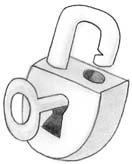The 1-2-3 Magic Workbook for Christian Parents: Effective Discipline for Children 2-12 (6 page)
Read The 1-2-3 Magic Workbook for Christian Parents: Effective Discipline for Children 2-12 Online
Authors: Thomas W. Phelan,Chris Webb
Tags: #Family & Relationships, #Parenting, #General

your sister doesn’t behave that way and your not—at 1 or 2. And that
father’s coming home in half an hour. Did God is going to make you feel
put you on earth to drive me crazy or what?!”
real good!
Tempting as this mini-lecture might be, you
simply remain quiet. If the child does something
else that’s countable, count it. If the child behaves, praise him and enjoy
his company.
What is going to happen, in a relatively short period of time, is this:
You’ll start getting good control—believe it or not—at 1 or 2. And we
will promise you this: The first time you stop a fight between two of your
kids across fifteen feet of living room, and all you have to do is say,
“That’s 1” or “That’s 2,” and you don’t have to get up or yell or scream
or do something worse which you’re going to be sorry about later...the
first time you do that, you’re going to feel real good!
Some parents ask, “My child always takes us to 2. He never seems
to stop at 1. Don’t you think he’s manipulating us?” The answer is, “No,
28 1-2-3 MAGIC
he’s not necessarily manipulating you by always taking you to 2.” Why?
Because what really drives people crazy is 42 or 72! Or a child who has
to be told a thousand times before he’ll shape up. Two times is not so bad,
and remember, if the child hits 3, he’s gone.
Other parents ask, with good reason, “What if my son or daughter
does something that’s so bad that I don’t want them to have three chances
to do it?” That’s a good question. For example, what if your child hits you?
Children hitting their parents is unacceptable. If your child hits you, it
would be ridiculous to say, “That’s 1,” and give him two more chances to
slug you. So if in your opinion the behavior is bad enough to begin with,
you simply say, “That’s 3, take 5 and add 15 more for the seriousness of
the offense.”
Let’s look at another example. What if your seven-year-old learns
a bad word on the playground? He doesn’t know what it means, but he
wants to try it out on you. So at 8:30 when you say it’s time to get ready
for bed, he replies, “You blankity-blank!” Same thing. “That’s 3, take
5, and add 15 more for the rotten mouth.” And in this example, when
that youngster returns from time out, a short explanation will be in order
concerning what the word meant and why he can’t use it in your house.
Explanations are appropriate when a child’s misbehavior is new or
unusual.
That’s it. That’s the essence of counting. Counting is extremely
simple, direct and effective. You are thinking that there must be a catch.
There is.
The Not-So-Easy Part
Occasionally I have run into parents who say this to me: “We went to
your workshop about eight weeks ago and we enjoyed it. We have two
fairly difficult kids, aged seven and five. When we went home we were
very surprised.
1-2-3 Magic
worked and our children were much better
behaved. But that was two months ago. The 1-2-3 is not working anymore.
We need a new discipline program.”
What’s the problem here? Ninety percent of the time—not all the
time—the problem is that the parents “forgot” the No-Talking and No-
Emotion rules. Adults can slip up like this without even knowing it.

COUNTING OBNOXIOUS BEHAVIOR 29
Remember our four-year-old tantrum artist and the potato chips? Here’s
how that scene might sound if the parent is unwittingly talking too much
and getting too excited while attempting to count the child’s outburst:
“That’s 1.... Come on now, I’m getting a little tired of
this.Why can’t you do one little thing for us—LOOK
AT ME WHEN I’M TALKING TO YOU, YOUNG MAN!
OK, that’s 2. One more and you’re going to your room, do
you hear me? I’m sick and tired of you whining and
fussing over every little thing you can’t have. One more and
that’s it. YOUR SISTER NEVER BEHAVES THIS WAY...
YOUR FATHER’S COMING HOME IN HALF AN HOUR!
OK, ENOUGH! THAT’S 3, TAKE 5. BEAT IT! OUT OF
MY SIGHT!!”
Whew! What was that? That was a parental temper tantrum. Now
we have two tantrums going on in the same kitchen. This adult’s outburst
was not the 1-2-3 at all. What’s wrong with what this angry parent just
did? Three things.
First of all, do you want to talk to a child Key Concepts…
like that? Did you have a bad day at the office? If Talk too much and you
you do “communicate” like this parent just did, take your child’s
the translation of what you are really saying is focus off the
simply this: “Let’s fight!” And you don’t have to need for good
behavior.
have an ADD (Attention Deficit) kid or an ODD Instead, you switch
(Oppositional Defiant) kid or a CD (Conduct your child’s focus onto
Disorder) kid—you’re going to get a fight. There the possibility of an
are plenty of kids who would sooner cut off their energetic—and perhaps
enjoyable—argument.
left leg than lose a good battle of words. Unwise
attempts at talking or persuading are guaranteed
to take a child’s focus off the possibility of good behavior and put it on
the prospect of an enjoyable and energetic argument.
Second, many difficult children do have Attention Deficit Disorder.
That doesn’t mean they don’t
get
enough attention. It means they can’t
pay
attention. How is an ADD child, or any other youngster for that mat-
ter, supposed to pick out—from that huge mass of adult words—the most

30 1-2-3 MAGIC
important parts, which are the counts or warnings? He can’t. Children
can’t respond properly to warnings if they don’t hear them clearly in the
first place.
Finally, there is a third thing wrong with our super-frustrated parent’s
message. Even if you forget all the emotion involved, as Mom or Dad
talks more and more, their message fundamentally changes. When a
parent gives lots and lots of reasons to a child regarding why he should
shape up, the real message becomes: “You don’t have to behave unless I
can give you five or six good reasons why you should, And, gee whiz, I
certainly hope you agree with my reasons.” This is no longer discipline.
The word describing this “strategy” starts with the letter B. It’s
begging
.
When you beg like this, you are (1) thinking for your child and (2) taking
the responsibility for his behavior.
What’s the average child going to do? He’s going to take issue with
your reasons. “Katie doesn’t always do what you say. Daddy’s not com-
ing home in half an hour.” Now you have left the discipline ballpark and
you’re out in the street arguing. The main issue has been forgotten. What
is the main issue? “Is the child behaving?” is the main issue.
So if the child is acting up, it’s “That’s 1” (bite your tongue). Then,
if necessary, “That’s 2” (easy does it, keep quiet), and so on. Remember
that the magic is not in the counting, it’s in the pregnant pause right after
the warning. In that moment—if the adult keeps still—the responsibility
for the child’s behavior falls squarely on the youngster’s own shoulders.
You wouldn’t want it any other way.
When it comes to counting, your silence will speak louder than your
words.
Our Famous Twinkie Example
Our Famous Twinkie Example will help you better un-
derstand the workings of the 1-2-3. Here is a situation
almost all parents have experienced at one time
or another. You are cooking dinner at 5:45 p.m.
and your eight-year-old daughter walks into the kitchen:
“Can I have a Twinkie?”
“No, dear.”
COUNTING OBNOXIOUS BEHAVIOR 31
“Why not?”
“Because we’re eating at six o’clock.”
Is there anything wrong with this conversation? No. The child asks a clear
question and the parent gives a clear answer. The problem, however, is
that most kids won’t leave it there; they will press the issue further by
adding, in a whiny voice, “Yeah, but I want one.”
What are you going to do now? You’re a little aggravated and you’ve
already given the necessary explanation. Should you repeat yourself? Try
to elaborate on your answer? Ignore the child?
Let’s play this situation out in three scenes. In Scene I, we’ll have
starring for us a mother who believes that kids are little adults. Words and
reasons will work everything out and change the child’s behavior. We’ll
see what happens with that approach.
In Scene II, our mother will be getting smarter. She will be starting
to use the 1-2-3, but the child won’t be used to it yet.
In Scene III, the mother will still be using the 1-2-3, and her daughter
will have grown more accustomed to it.
Scene I—Starring the Mother Who Believes
Kids Are Little Adults:
“Can I have a Twinkie?”
“No, dear.”
“Why not?”
“’Cause we’re eating at six o’clock.”
“Yeah, but I want one.”
“I just told you you couldn’t have one.”
“You never give me anything.”
“What do you mean I never give you anything? Do you have
clothes on? Is there a roof over your head? Am I feeding
you in two seconds?!”
“You gave Joey one a half-hour ago.”
“Listen, are you your brother? And besides,
he
eats his
dinner.”
“I promise I’ll eat my dinner.”
“Don’t give me this promise, promise, promise stuff, Monica!
32 1-2-3 MAGIC
Yesterday—4:30 in the afternoon—you had half a peanut
but er and jel y sandwich and you didn’t eat anything at dinner!”
“THEN I’M GOING TO KILL MYSELF AND THEN
RUN AWAY FROM HOME!!”
“WELL, BE MY GUEST. I’M SICK OF THIS!!”
You can see where trying to talk at the wrong time can get you.
Though everything Mom said was true, her talking made things worse.
In the next scene, Mom is getting smarter and starting to use the
1-2-3, but it’s new and the child is still getting used to it.
Scene II—Starring the Mother Beginning the 1-2-3:
“Can I have a Twinkie?”
“No, dear.”
“Why not?”
“Because we’re eating at six o’clock.”
“Yeah, but I want one.”
“That’s 1.”
“You never give me anything!”
“That’s 2.”
“THEN I’M GOING TO KILL MYSELF AND THEN
RUN AWAY FROM HOME!!”
“That’s 3, take 5.”
Mom did much better. The temporarily unhappy child disappears
for a rest period and the episode is over.
How’s it going to go when the child is more used to counting and
realizes that testing and manipulation are useless?
Scene III—The 1-2-3 After a Few Days:
“Can I have a Twinkie?”
“No, dear.”
“Why not?”
“Because we’re eating at six o’clock.”
“Yeah, but I want one.”
“That’s 1.”
(Pause) “Oh, all right.” (Grumpy exit from kitchen)
